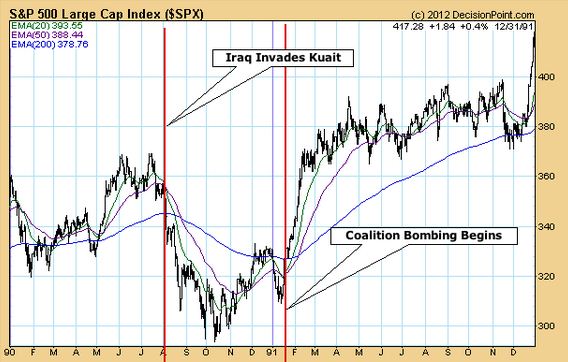This is an excerpt from the March 9, 2012 blog for Decision Point subscribers.
We are in the midst of turbulent times, and it seems inevitable that things can only get worse. When casting about for a safe investment, it seems that gold is one of a very few areas of safety (and I don't know what the other ones are); however, when we look at historical charts, it is obvious that gold doesn't always behave in the way we would expect.
Below we have charts of the S&P 500 and gold from the period of the first Gulf War. I can still remember the high level of fear in the U.S. that the war would result in unimaginable casualties for the Coalition. Some 20,000 body bags were stockpiled, and there was fear that that would not be enough.
As we can see, stocks behaved in a predictable way -- crashing when Iraq invaded Kuait in August, then rallying within hours of the initial bombing in January, when it became obvious that the worst fears were unfounded.
Gold, on the other hand, rallied when Kuait was invaded, but then it began to meander in a wide range, ending with a final rally just before the Coalition attack began. Once the outcome of the war was known (almost immediately), gold resumed normal trading. One might have assumed that gold would rally continuously during the period of uncertainty, but one would have been wrong.
Another more recent period of uncertainty was the triggering of the global financial crisis in late 2007. Stocks declined for over a year until making a bear market low in early 2009.
Gold, on the other hand, rose over 300 dollars from 2007 to early 2008. Then it began a wide-ranging decline into late 2008, during which it lost almost all its initial gains. One might have thought that gold would have maintained a steady climb during the entire period of the crisis, but, again, one would have been wrong.
After the low in 2008, gold began a steady rally that ultimately took the price to over 1900, so from that point of view, gold was a big winner in the face of the financial crisis. However, the 30% correction in 2008 had to have been a period of major confusion and high anxiety for those who thought their investment in gold was supposed to protect them from the fallout of the financial crisis.
Conclusion: We can devise logical scenarios as to what the price of gold should or should not do, but gold doesn't always follow the plan. To paraphrase an old Jewish saying: "Man plans. Gold laughs." We can't really predict how gold prices will behave in an inflationary or deflationary environment. Even if the gold bugs' dreams do come true, there is always the chance that the rules will change, like when FDR conficated most of the gold owned by American citizens.
It is not my intention to discourage investment in gold, just to temper some of the high expectations that emerge from those wild and crazy gold commercials. It is hard to make money in any market, and perfectly good logic is often thwarted. The best we can do is watch the charts and follow the trends.










